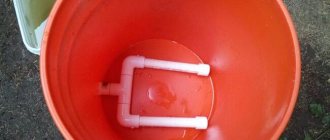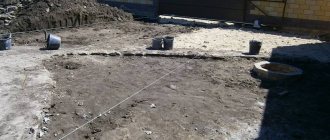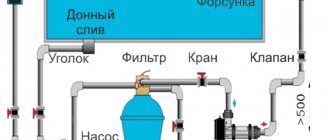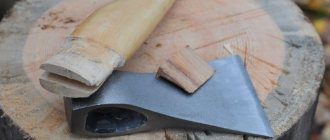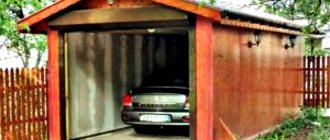Ecology of consumption. Estate: A vacuum cleaner for a swimming pool is an excellent invention for cleaning its surfaces. A DIY pool vacuum cleaner is a simple invention that is even fun to work with.
A pool vacuum cleaner is an excellent invention for cleaning pool surfaces. Regardless of the quality of the installed inlet filter, plaque forms on the walls of the pool and on its bottom. In addition, dirt often gets into the pool in the form of leaves and dust, which, when deposited, creates an unpleasant layer on the surface. Such stains can be removed in many ways, but one of the best is a pool vacuum cleaner. Making it with your own hands is quite simple, and today DachaDecor.ru will help you decide on this task.
Pool cleaning methods
There are many ways to keep your pool clean. One of them is constant replacement of water and filling the pool through special filters. In this case, the water will not have time to stagnate and pathogenic organisms will not be able to quickly develop in it. However, this method is very expensive, because the water will have to be changed at least 1-2 times a week... and there can be a lot of it.
Depending on the size of the pool, even if even a small frame is installed at the dacha, the amount of water can reach tens of cubic meters. Even an average pool with dimensions of 4x2 m and a depth of 1.2-1.5 m is already more than 10 cubic meters of water. Just calculate how huge the expense will be. But that is not all. Of course, with water from a pool that has been in it for only a few days, you can wash your car, irrigate trees, rinse even the façade of a house, or water all the beds in your garden. But how much water will it take? A cube or two? Where should the rest of the water go? Pour it down the drain?
It’s good if so, but often there is no central sewage system in the country. Then the water is drained into the nearest ditch, but this is fraught with many problems - from the development of harmful microorganisms there to the creation of a small swamp with frogs and snakes.
In general, this is not an option, unless you have a pool at your dacha that only holds a cube or two of water, for example, an inflatable pool for children. Then, in principle, the question of cleaning it disappears. But we are talking about medium-sized pools, and therefore we need to look for the right method.
- You can use a distillation pump with filters, but you must understand that it only purifies water. That is, depending on the technology and equipment used, the water will be purified from microscopic impurities and organisms that can create a pathogenic environment;
- You can also use chemicals to clean the pool, which will simply turn the water into a dead state. But again, you will only get rid of bacteria, but not of debris on the surface of the water and plaque on the walls of the pool;
- Using a special net will help collect leaves and pieces of paper from the surface of the water, and a brush with a long handle will help remove some of the plaque from the waterline. But the rest of the dirt will simply settle and remain at the bottom.
As you can see, cleaning a pool that is filled with water is no longer as simple a task as it was previously thought when purchasing a pool. Here it is necessary to use complex methods, one of which will be a vacuum cleaner for the pool.
Why do you need a water vacuum cleaner for a pool?
Water not only in indoor but also in outdoor pools becomes polluted over time. While large debris can be easily caught with a net, dust and sand cannot be removed. Pollutants make the water cloudy and settle as sediment on the bottom and walls of the font. It is impossible to frequently drain tons of water in order to wash the bowl of dirt. This is where a water vacuum cleaner comes to the rescue. The unit helps clean dirt accumulations without draining the pool water.
Special attachments are convenient to use on smooth and textured surfaces. In addition to the bottom and walls, the steps of the pool are cleaned with a vacuum cleaner. The device copes well with mold in case of algal blooms.
Stages of connecting and disconnecting the vacuum cleaner to the filter system
Connecting a handheld vacuum cleaner to the pool filter is simple. One side of the hose is connected to the skimmer using a special adapter, and the other is attached to the vacuum cleaner. Let's look at how to start vacuuming in more detail.
Beginning of work:
- Run the filter in the “filtering” mode;
- Fix the vacuum cleaner rod in a comfortable position;
- The vacuum cleaner nozzle is lowered to a depth (for this they are called “bottom” vacuum cleaners);
- The vacuum cleaner hose fills with water;
- If the skimmer is built-in, then the cover is removed;
- The remaining skimmers are closed with plugs;
- Using a special attachment, the vacuum cleaner hose is hermetically connected to the working skimmer.
When the pump starts working, all the garbage is immediately sent to the skimmer or directly to the sewer.
Shutdown:
After cleaning, you need to disconnect the hose from the skimmer and put away the vacuum cleaner. Switch off the pumping system. Rinse the skimmer basket. Set the filter to backwash and start the pump. When the water in the viewing window becomes clear, the pump can be turned off. Then the pumping system is started in the “flushing” mode for one minute. After cleaning, the filter system operates as usual
It is important to know that before each mode change, the pumping system must be turned off!
Together, vacuum cleaners and sand filters for pools (including frame pools) perform an ideal cleaning job. The main thing is proper care of the units. Use the vacuum cleaner correctly, and wash the filter and change it if necessary.
Moreover, direct interaction of the filter occurs only with three types of vacuum cleaner: manual, vacuum and semi-automatic. If you take an automatic model, then it already has a special filter built into it that holds all the debris.
How does a pool vacuum cleaner work?
The operating principle of all water vacuum cleaners is the same. The device sucks up dirt and water, passes it through a filter, and throws clean water into the pool. However, due to the different designs of the models, there are small nuances. Automated robots are independent. The unit is simply immersed in water, where it does the cleaning itself. A manual pool vacuum cleaner has a similar operating principle, but the connection is different. The hose is connected to the skimmer at one end, and a brush is attached to the other end. From the name of the device it is already clear that it will have to be controlled manually.
Important! The nozzles of any vacuum cleaner carefully treat the surface of the bowl. The device can clean not only concrete, but also frame and inflatable hot tubs.
What do we have to do
The practical side begins with the purchase of building materials with a reserve. Even professionals do not always correctly calculate the expected consumption. The master will need:
- container (steel or plastic);
- filter for coarse cleaning;
- cleaning mesh (with small cells);
- flexible hose;
- container/container in which chemically active substances are stored.
The step-by-step plan for making a skimmer starts from the bottom of the working tank. A funnel is made in the found container to draw water from the bowl. The cleaning mesh is fixed on the funnel. Make sure that the width of the holes is sufficient to trap small and large particles. Further procedure:
- in the middle part of the future skimmer, small containers are installed to contain chemically active substances that are responsible for water purification;
- an element for rough water purification is installed inside the filtration device;
- a coarse filter is a fragile device that is better to buy ready-made if a person does not have experience;
- use a drill to make an outlet hole, the diameter of which is equal to the diameter of the hose;
- the hose is connected to a stationary circulating pump.
The instructions given apply to the built-in model. If you use a mounted option, then the procedure is different. The body is made as described above.
The next step is to create a float:
- make a hole with a diameter of 0.5 cm on the lid, which is needed to close the pipe;
- such a cutout should not be too close, but there should not be a large gap;
- to remove excess air level, make another hole closer to the edge;
- install the cover in the middle part of the small pipe;
- wrap foam rubber closer to the edge;
- fix the foam with electrical tape.
The stage is considered complete if no poorly fixed parts are found. The final touch is the creation of the main part of the body of the mounted unit. To do this, take a piece of a large pipe. Stable operation is ensured by installing an adapter that connects the pump body and pipe. As soon as all the elements of the system are joined, the procedure for installing a homemade filtration device is completed by applying a sealing compound.
Note! To drain dirty water, a short flexible tube is used to drain the filter.
The built-in or mounted skimmer is complemented by a pumping system. Its power is directly proportional to the size of the water surface. A flexible tube is passed through a valve installed in the wall of the pool. Then the skimmer itself is fixed. The depth of immersion depends on the type of skimmer selected. During work, make sure that the edge of the incoming pipe is located at a depth of 3 to 5 meters.
How to make plastic gazebos for your dacha with your own hands: design options, detailed instructions
A plastic or steel skimmer for a permanent or seasonal pool with your own hands saves your budget. The design of the system does not require special engineering knowledge, so only tools are required for operation. First, they draw up a drawing that takes into account the area of the water surface, the intensity of use of the pool, and so on. The next step is to select the required number of skimmers. The calculation is based on the formula. For every 25 m³ of bowl volume, a separate gadget is required.
Types of vacuum cleaners for cleaning pools
Devices of different power, design, and manufacturer are available for sale, but this is not their main difference. The main type of water vacuum cleaner is the control method.
Handheld vacuum cleaners are considered the easiest to operate and affordable. The unit is distinguished by its simplicity of design, where a hose with a nozzle is connected to the filter. Any craftsman can assemble a handheld vacuum cleaner. Most of the components are used from a conventional dust suction apparatus.
Typically, all handheld vacuum cleaners are supplied with two attachments by manufacturers. The brush helps clear the bottom and walls of the pool from settled dirt. A net helps collect large floating debris from the surface of the water.
Advice! A handheld vacuum cleaner is convenient for do-it-yourself maintenance of small frame and inflatable hot tubs.
The semi-automatic device has become a middle link between a robot and a manual vacuum cleaner. Control occurs in the same way manually, but due to additional automatic functions, the quality of pool cleaning is improved. Semi-automatic machines have a valve that independently sets the optimal water flow rate. A dirty unit can be easily washed. The brush design is different. With a semi-automatic device it is more complicated, due to which the unit copes better with cleaning the hot tub.
Water apparatus of this type are equipped with a hydraulic unit. Its design includes a membrane that serves as a suction cup. When the vacuum cleaner finishes removing dirt in one place, the membrane comes off the surface of the bowl. The nozzle moves with gentle bouncing to another contaminated area.
Advice! The semi-automatic device is suitable for cleaning stationary, inflatable and frame pools of medium volumes with different bottom shapes.
Automata are also called robots. The vacuum cleaner does not require human assistance to clean the pool. The unit performs all actions itself. An advantage is the fact that the robot does not require connection to a skimmer. The vacuum cleaner is completely submerged under water, moves independently, and performs cleaning functions specified by the program. During operation, the device consumes little electricity.
Robots usually have two modes of operation. The first program is aimed at normal cleaning. The vacuum cleaner independently cleans the font from dirt, and turns off after completion of work. The second mode uses a remote control. Manually setting programs during operation allows you to remove heavy contamination from a pool with a complex bottom surface.
Advice! Robots are best used for cleaning large stationary pools.
Criterias of choice
Choosing the right type of device to pump water out of the pool is not easy. You need to have an idea of the operating conditions, design features and parameters of pumping units.
When selecting the right model, all aspects related to pumping water from a given pool are consistently considered in order to determine the most successful combination of characteristics.
By material
Technoplast parts can be used in the design.
They are less durable than all-metal models. At the same time, the pools use fairly clean water that does not have large suspended particles. Therefore, in this case, you can use models with a plastic impeller.
In addition, you need to carefully consider what kind of metal is used in the manufacture of the pump. Since it deals with water, the possibility of corrosion must be excluded, so a stainless steel model would be the best option.
There are often situations where the body itself is made of stainless steel, but the fastening elements are made of ordinary steel. Such models will not be able to work for a long time, and when performing repairs they will create additional difficulties - rusty screws significantly complicate disassembling the device.
According to the characteristics of the pumped medium
Pumps are divided into groups according to the type of pumped medium:
- for clean water with a low permissible content of fine solids;
- for water with a certain content of solid inclusions (usually, the characteristics of the model indicate the permissible value and quantity of foreign components);
- mud pumps designed for pumping out thick and viscous liquids.
Pool water, even the dirtiest, does not contain large amounts of solid particles. Therefore, when choosing a pump, you can consider models from the first group.
By performance
Pump performance is the main characteristic that determines how quickly it can pump out all the water from the bowl.
In order to choose the right model, you need to know the volume of your pool and the amount of water in it.
When considering the characteristics of the device, it is necessary to take into account in what units the productivity is indicated - it can be m3/h, or l/min.
You need to know that one m3 contains 100 liters, i.e. The pool has a volume of 3.7 m3 and holds 3700 l. This way you can roughly calculate how long it will take for this model to pump out all the water. If it takes a whole day (or several days) to complete the task, you need to look for a more efficient pump.
By diameter
The diameter of the pump body does not matter since the pool is large enough to accommodate the pump body or hose without difficulty.
However, it is recommended to pay attention to the dimensions of the suction pipe or the diameter of the suction hose (on surface models). The cross section of these elements determines the throughput and indirectly determines the performance of the device
It is recommended to choose models with large diameter suction pipes or receiving elements.
By type of switch
There are pumps with manual start and stop. However, when pumping a pool, the work takes a lot of time.
The owner may miss the moment when the water has already been removed and it is time to stop the pump. Therefore, it is recommended to use models with a float switch.
As soon as the level gets too low, the float will drop and command the pump to turn off. This will help protect the device from overheating.
How to make a water vacuum cleaner for a pool with your own hands
There are different options for assembling homemade units. Often a hose and brush from a regular vacuum cleaner are used as a nozzle. Two designs are considered a good option: one is designed for removing large debris with your own hands, and the other is for silt.
If the font is located in the open air, the water is often contaminated with grass, fallen leaves, and insects. In this situation, it is better to assemble a water vacuum cleaner for the pool with your own hands with a bag that allows you to collect large debris.
The materials you will need are shaped elements from a plastic sewer: 90 or 45 degree elbows, 50 mm in diameter, a piece of pipe, 30 cm long and 100 mm in diameter, an adapter from 50 to 100 mm in diameter for a homemade brush. For the hose, use a corrugated hose that is connected to the washbasin siphon. The working unit will be a filter pump, which must be purchased in the store.
After preparing all the materials, they begin to assemble the bottom vacuum cleaner for the pool with their own hands, following the steps of the step-by-step instructions:
- You can sew a garbage collection bag from thick fabric with your own hands. The material must allow water to pass through well. A piece of an old nylon curtain without holes will do. The resulting cone-shaped bag is inserted inside a plastic pipe with a diameter of 100 mm. From the entrance side it is fixed with a rubber sealing ring.
- The next step is making your own brush. The body of the element is an adapter from a plastic pipe with a diameter of 50 mm to a similar pipe with a diameter of 100 mm. The larger end of the shaped element is cut at a slight angle. To prevent the edges of the plastic from scratching the bottom of the pool, foam sponges are glued. The soft material will clear away the mucus. To remove hard dirt, the edges of the adapter cut at an angle are framed with a linoleum ring. The lower part of the frame is cut into strips to form a brush.
- Assemble a vacuum cleaner for a frame pool with your own hands using shaped elements. The brush is connected with an adapter and bends to one end of the pipe with the bag. An adapter with a branch is similarly placed on the second end.
Finally, it remains to connect one end of the corrugated hose to the outlet, and connect the other to the pump. The vacuum cleaner for cleaning the pool is ready. However, due to the lack of a handle, you will have to hold it by the thick pipe while cleaning. A vacuum cleaner is convenient for cleaning shallow inflatable pools up to 75 cm deep.
Advice! A similar design will make a vacuum cleaner from a plastic bottle, where the container is used instead of a piece of thick pipe. However, this design has a drawback. The soft walls of the bottle can become wrinkled during operation, making cleaning difficult.
If the pool is located under a cover, leaves and grass will not fall into it. To remove sludge, a vacuum cleaner of a simplified design is assembled. The materials you will need are a brush from a conventional dust suction device, a corrugated hose, a pump, and a piece of polypropylene pipe 1 m long.
The tube is used for the handle. It is better to calculate its length taking into account the person’s height. However, the parameter 1.2 m cannot be exceeded. The long handle will bend when cleaning the pool. The vacuum cleaner will become inconvenient to use.
After preparing all the materials, a homemade pool vacuum cleaner is assembled in the following sequence:
- A pipe handle is attached to the outer wall of the brush inlet. The joint is sealed with tape.
- Corrugated hoses are connected to the pump. The connections are tightened with clamps. To prevent them from scratching the surface of the pool bowl, the joint area is wrapped with electrical tape.
- The hoses are immersed in the pool and given time to fill with water. One end of the corrugated pipe is inserted into the inlet hole of the vacuum cleaner brush with your own hands. The second end of the hose is connected to the hole of the device for suctioning water. Now all that remains is to turn on the pump and check the functionality of the invention.
The vacuum cleaner according to the second scheme is easy to assemble with your own hands. It is suitable for cleaning stationary, inflatable and frame pools, but it will not be able to suck up large debris.
Video of a DIY pool vacuum cleaner:
Sand option
Not the easiest to assemble, but still quite an effective sand filter for a pool, you can construct it yourself. This device is a static tank filled with special sand for swimming pools.
Water passes through this sand, is purified and returns to the bowl. Dirt accumulates along the edges of the filter. It needs to be cleaned at least once a week using reverse flow, which is not economical in terms of water consumption.
What does it need?
To assemble a sand filter-pump for a swimming pool with our own hands, we will need the following materials:
- Pump pump. It is advisable not to take it too powerful; 150 W will be quite enough.
- Plastic container with lid, 40 – 50 l. A wide top entrance is desirable.
- Filler. It can be quartz sand, graphite, coal, etc. Read about filler options below.
- Hoses.
- Clamps.
- Coarse water filter.
- Water intake with fine mesh.
Filler selection
Filters of this type use different types of fillers: sand, coal, graphite, and even devices with glass chips. However, using glass in a homemade filter can be dangerous.
It is also important that the contents are not too small. In this case, the entire filtration system may become clogged.
Sand is the most popular existing filler. It traps debris as small as 20 microns and will keep the pool relatively clean. For additional disinfection of water, quartz sand is also used.
A serious disadvantage of this filler is its rapid clogging; sand also clumps into clumps over time and forms channels through which the water is not purified. This makes sand not the easiest media to maintain.
Graphite and coal also have similar problems, but they trap smaller dirt particles. The cost of such fillers is slightly higher.
Sometimes the contents of sand filters are combined by adding different types of fillers in several layers. This creates a multi-stage cleaning system. However, using more than three different types of filler is not recommended.
How to do it yourself?
install it near the pool
Fill the container with sand. Connect a hose to the top of the tank that will draw water from the pool. A coarse filter must be placed between the tank and the pump.
Next, a hose is connected to the pump, which returns the water back to the pool. This completes the assembly of your device.
Exploitation
Lower the two tubes into your pool. It is advisable that they be as far apart as possible. After this, turn on the pump. The water will begin to flow into the sand tank, where, after being filtered, it will reach the water collector, the fine mesh on which will prevent the sand from passing further with the water.
Next, through the hose, the water will flow into the coarse filter. It is needed in order to definitely clean the water from sand that could seep through the mesh of the catchment. Afterwards, the water enters the pump, which, in turn, distills the purified water back into the pool.
This option needs cleaning once a week. It is washed by running water back. Such water is no longer suitable for use and, as a result, is thrown away. This significantly increases water consumption.
From this video you can find out how to make a homemade sand filter for your pool with your own hands:
We looked at two of the most popular pool filter options. All materials for their assembly can be found at any hardware store.
From the above, it becomes clear that a cartridge filter is more convenient and economical to manufacture. It does not require a large number of parts, and it is much easier to assemble. If you calculate the costs, then a homemade version will be much cheaper than a ready-made one, while the power of a ready-made filter and a self-assembled one is approximately the same.
the cartridge is much easier to wash, although you will have to do it much more often
The sand machine is much more powerful and faster. However, it does not provide the same quality as the cartridge version. The sand filler retains pieces of dirt from 20 microns in size, while the cartridge allows you to retain particles from 5 microns. It is also much larger and more difficult to assemble.
From a financial point of view, a homemade sand filter is not much cheaper than its ready-made counterpart. Not to mention the time and effort spent on its design and installation.
Be that as it may, the choice is yours in any case. Both options will help to significantly improve the quality of water in your pool, thereby making water procedures more enjoyable and safer.
How to use a pool vacuum cleaner correctly
The easiest way to clean is with robots. The vacuum cleaner is given a program, connected to the power supply, the start button is turned on, and immersed in the pool. Due to rotating rollers and specially shaped hard brushes, the device moves independently, reaches hard-to-reach places, and cleans dirt. If the route is difficult, the program is switched to remote control.
Most manufacturers equip their vacuum cleaners with several modes that have a set of certain standard functions. The user only needs to make a choice and flip the switch. The type of mode is usually chosen taking into account the type of finish of the bowl, the degree of contamination, and the design of the font.
Robots are equipped with sensors. If the vacuum cleaner encounters an obstacle, it analyzes the situation and chooses a direction for further movement. Most of all modern machines are battery operated. Vacuum cleaners are silent and adhere well to the walls of the font due to the constant flow of water passing through the filter. Robots are excellent at cleaning dirt from tiles, mosaics, concrete, and PVC finishes.
Easy-to-assemble instructions for a manual or semi-automatic vacuum cleaner. The unit consists of a working brush attachment, a sliding handle and a corrugated hose. All elements are connected and connected to the pump. During the cleaning process, the water passes through the filter and the purified water is returned to the pool. There are vacuum cleaner models with a built-in filter, as well as an autonomous pump for pumping water.
For most hand-held devices, the assembly procedure is the same. First, a hose is connected to the brush inlet. A telescopic handle is fixed to the second bracket on the surface of the nozzle body. It is laid out to the required length, allowing you to reach the site of contamination.
The free end of the hose can be connected to three places, depending on the type of system:
- to the skimmer adapter;
- to the pipe connected to the skimmer hole;
- to the pipe connected to the inlet of the overflow type hot tub adapter.
After connecting all the elements, the working part is immersed in the pool. The hoses are completely filled with water. Check for the absence of air inside the system. Immediately adjust the required length of the rod and hose. If the skimmer is of a built-in type, then remove the cover from it. All other types of skimmer are closed with a plug. The filter is turned on to the main cleaning mode, and the brush begins to pass along the bottom and walls of the pool. If the water is heavily polluted, there is no point in running it through a filter. It will clog quickly. The valve is switched to drain mode. The free end of the hose is directed into the sewer, where large accumulations of sludge collected with your own hands in the pool are discharged. If necessary, the font is replenished with clean water.
At the end of cleaning, turn off the vacuum cleaner. The hose is disconnected from the skimmer. After stopping the pump, wash the skimmer baskets. The filter switch is set to the backwash position and the pump is started. The procedure continues until the dirty stream is replaced by clean water. The pump is stopped, and after a short period of time it is started again for 1 minute. After cleaning, the pool system is started to operate in daily mode.
Subtleties of operation
Before cleaning the pool with a handheld vacuum cleaner, you must first secure the bracket inside the brush eyes. Another part of the bracket is used to install an outer rod that is secured with a latch. The rod must be pulled out depending on how far away the contaminated area is. One end of the hose is connected to the brush outlet. Another:
- or to the adapter from the skimmer kit;
- or to the end screwed into the skimmer hole;
- or to the end screwed into the inlet of the overflow bowl adapter.
By connecting the rod and brush to the hose, you can lower the device into the water. Next, you need to fill the hose 100% with water. Acceleration of the process is achieved by supplying a jet from the nozzle. Part of the hose is connected to the skimmer or adapter. The length of the hose is immediately adjustable.
Before installing the filter unit, you need to check:
- lack of air inside the hose;
- lack of power supply;
- correct program.
The filter is started for basic cleaning. Next, fix the working rod as conveniently as possible. The nozzle is immersed in the pool. Fill the hose with water. When using a built-in skimmer, remove the cover, and other types of skimmers must be covered with plugs.
All you have to do is use a special nozzle. It will allow you to tightly connect the hose to the working skimmer. There are strict requirements for completing the work. Once the cleaning is completed, the hose and skimmer are disconnected. The vacuum cleaner is put aside.
The next step is to turn off the pumping system. When this is done, rinse the skimmer baskets. The filter itself is switched to return washing and the pump is immediately started. After waiting until the flow stops being cloudy, it is turned off. Then it is turned on again, this time for washing, for only 60 seconds.
Once all parts have been cleaned, you can use the system in everyday use. Changing modes is allowed only after turning off the pump complex. It is strictly forbidden for air from the vacuum cleaner to penetrate into the filter housing.
A pressure gauge helps determine whether the filter system is working properly. Very high pressure indicates a blockage. This risks causing defects. Experienced owners of water vacuum cleaners monitor how the liquid in the bowl evaporates. The protection of the motor from air ingress depends on its level; For greater peace of mind, water is added every 24 hours.
It is strictly forbidden to run the cleaning system and vacuum cleaner if someone is bathing. It is not advisable to enter there until the purifier's work is completed. After turning off the taps, immediately turn off the vacuum cleaner. These safety rules also apply to the use of robots. You will have to carefully monitor the behavior of small children and pets.
Cleaning attachments are selected at your discretion. Even the smallest experience allows you to do this without problems. Before cleaning, check that the hoses are securely fixed and that moving parts are covered. If you use a vacuum cleaner with an internal filter, check its serviceability before starting it and clean it if necessary.
To learn how to make a pool vacuum cleaner with your own hands, see the following video.
Kokido Telsa 30
Description
Cleans small and medium-sized ponds well. There is no need for wires, because Charged by built-in battery. Cleans surfaces using the side brushes of the floating head.
Options
- filter capacity 550 ml;
- depth min and max at which work is possible – 250 mm and 3000;
- Lithium-ion battery with a capacity of 2000 mAh.
Cyclone filter
The design of cyclone filters makes them much more convenient and efficient than conventional garbage disposals. Due to their spaciousness and hygiene, such purification systems are becoming increasingly popular. However, not everyone can afford the high cost.
The principle of operation is as follows: the air flow passes through primary filters, which trap small dust particles. Next, the air enters the cyclone filter - a container in which, under the influence of the vortex effect, larger particles of debris swirl and settle to the bottom under their own weight. At the outlet, the air is 98% purified.
Materials for production
The simplest way to make a cyclone filter is to use a plastic bucket as the main element. The volume is calculated quite simply. For every 100 W of power, add 1 liter of capacity.
Expert opinion
Nikolai Petrovich
Subpage for an expert
A mandatory requirement for the container is the presence of a hermetically sealed lid.
In order to design a cyclone system filter, you will need the following tools:
- stationery knife;
- glue gun;
- silicone;
- compass.
Materials you will need:
- container with a lid (you can use paint or building mixture buckets);
- 45° elbow - 2 pcs.;
- 90° elbow - 2 pcs.;
- O-rings;
- plastic pipe.
The manufacturing process is carried out as follows:
- Two holes are made along the edges of the lid, the diameter of which coincides with the diameter of the pipe. In this case, the holes should be 4 cm from the edges.
- Silicone is applied to the edges of the holes, after which a sealant is inserted into the inner part, and then the knee itself.
- The outer side of the elbow is located almost at the level of the lid. From the inside, the pipe is directed to the center of the container and is also equipped with a 45° rotation.
- The second elbow is also supplemented with a rotating part on the inside, but in such a way that it is directed towards the wall of the bucket.
- When connecting elbows, it is necessary to use rubber seals (rings).
- Next, the structure is attached to the vacuum cleaner. The pipe, which is located on the outside at the level of the lid, goes to the vacuum cleaner hose, the second one goes to the corrugated pipe, which will bring out a clean air flow.
Pros and cons of a homemade device
Its advantages are:
- no need for frequent water changes;
- gentle cleaning without the risk of damaging the pool bowl;
- high-quality processing of steps, walls and bottom;
- simple self-cleaning process, without the involvement of specialists;
- water filtration, which helps improve the overall appearance of the artificial reservoir;
- reducing the load on pool filters;
- reducing the consumption of cleaning chemicals;
- saving money and time.
The disadvantages of the device include:
- lack of ability to switch power;
- impossibility of working in automatic mode;
- the need for constant direct human participation.
Brief overview of popular brands
Option #1 – Mountfield
The Czech company Mountfield specializes in manual models. Kits for connecting to the skimmer are sold in disassembled form and include at least a telescopic tube-holder (2.5-4.8 m), a corrugated hose of various lengths and a brush attachment. The length of the hose may vary, but on average it is 9 m or 12 m. The cost of the kit is 3,500 rubles.
Mountfield kit parts are sold separately, so if a telescopic rod, hose or attachment fails, they can be easily replaced with similar ones
Option #2 – Pondovac Classic
Owners of picturesque ponds are probably familiar with German pond cleaning devices from Oase. For the most part, these are universal machines used for cleaning both ponds and premises.
The 1400 W Classic model has a large 27 liter debris tank and a large set of attachments, including handy tools specifically for cleaning depressions and crevices or removing string algae. The device is equipped with two hoses: for water suction (4 m) and for draining (2 m). The vacuum cleaner has proven itself to be excellent when working at a depth of up to 2 m. The cost of the device is 11,600 rubles.
Pondovac Classic is a favorite of practical Germans. In summer it is an excellent helper when cleaning a pond, in winter it is an excellent washing vacuum cleaner for the home, powerful and comfortable to use.
Option #3 – Dolphin Galaxy
The Israeli company Maytronics produces quite expensive, but high-quality and reliable robotic vacuum cleaners. One of the relatively inexpensive ones is the Dolphin Galaxy automatic machine, ideal for ponds with a flat, level bottom. A specially shaped combination brush (40 cm wide) perfectly cleans both the bottom and corners. The device is equipped with a fine filter that retains particles of debris and dirt up to 70 microns in size. Cost – 41,000 rubles.
The Dolphin Galaxy robot vacuum cleaner independently scans the bottom area for cleaning, and is also capable of cleaning a small pond in just two and a half hours
The choice of a water vacuum cleaner depends on the availability of free time, the desire to spend more time outdoors and, of course, on financial capabilities.
Owners of pools for a country cottage or country house know that a reservoir with liquid not only brings joy on summer days, but also poses the task of removing debris from the water, which regularly tends to pollute it.
Kokido Telsa 10
The cheapest, but most effective in the series of manual cleaners is the Kokido Telsa 10. If a small pool needs to be cleared of floating debris, this is what you need! You don’t need to buy anything additional: a 500 ml filter bag, a 1.8-meter long rod - everything is included in the package.
The device is powered by a 2000mAh, 7.4V lithium-ion battery, which ensures continuous operation for forty minutes. After that, to replenish energy, it is connected to the built-in battery for 3-4 hours.
The design is on wheels, so it moves along the bottom without hindrance. Sticky debris is scraped off using a small, replaceable brush.
Options
- Power -100 W;
- Depth of work - 40 - 200 cm;
- Manufacturer – China;
- Surface to be cleaned – bottom:
- Filter capacity – 500 ml;
- Number of rods – 1 (4 sections);
- Pool area - 11 sq.m.;
- Suction nozzle size -15x55 mm.
We recommend:
- Intex 28001 for swimming pools: advantages, operation, price
- Neato XV Signature Pro: review, reasons for popularity, modes, price
- Automatic vacuum cleaners - advantages, price, features: TOP6
Equipment
The kit includes:
- device;
- filter;
- clip-on brush;
- cover with wheels;
- four-section rod 180 cm long;
- management.
Video: Kokido Telsa10™ – Rechargeable Handheld Pool Cleaner
Advantages
The advantages of vacuum cleaners for cleaning pools are:
- less labor-intensive process of mandatory water purification; ability to cope with any type of pollution;
- reducing the amount of time spent on cleaning and purifying liquids;
- preventing frequent changes of water, and consequently the appearance of ditches and swamps infested with microorganisms;
- simplicity and ease of use.
Today, the use of vacuum cleaners to purify water in swimming pools (regardless of their size and configuration) is considered the most effective way; the management of aquatic entertainment centers put such devices in first place.
Which manufacturer's equipment is better?
The number of manufacturers of pool vacuum cleaners is only increasing every day. Despite this, finding a device worth your money is quite difficult. But there are a number of brands that offer productive and easy-to-maintain units at reasonable prices.
The list of the best manufacturers includes:
- Intex;
- Ultramax;
- Zodiac;
- Dolphin;
- Mountfield;
- Bestway;
- Watertech;
- Emaux.
Please note that the companies presented above have both successful and not so successful models. So don't buy anything blindly. To save time and money, thoroughly review the technical specifications and the device itself. Only after this make your final decision.
When maintaining a swimming pool, an integrated approach is required. Before you start vacuuming, you need to treat the water with coagulants that convert dirt particles into flakes. In this form, debris is easier to remove. Read about the rules for choosing and using coagulants in this article.
Creating a Cleaning Brush
A brush for collecting debris and collecting water can be purchased, taken from unused attachments of a home vacuum cleaner, or made with your own hands.
The first two cases were described earlier, and for the third there are the following recommendations:
- take a polypropylene plumbing pipe that supplies water in the room, and separate 20-30 cm from it, and then make a cut along the pipe 5 mm long;
- divide the pipe in half and stick it into a polypropylene (p/p) tee, solder the joints;
- In the 3rd hole of the socket, install a part of the plastic pipe, which will become an adapter between the hose and the brush, and in the first 2, which has a slot, it should be plugged on all sides (sub plugs).
- the resulting homemade brush can be improved by gluing (screwing with self-tapping screws) an elastic band from a windshield wiper from the windshield of a car or strips with bristles onto a pipe with a slot for better collection and cleaning of dirt.
The brush should come out rounded and smooth so that the walls of the pool are not damaged. Soldering and gluing must be carried out carefully and only with high-quality materials, so that the homemade product does not fall apart in water. The slot in the pipe (for collecting water) should be made at an angle and so that the rubber bands (wipers) for removing dirt do not interfere with the collection of debris.
